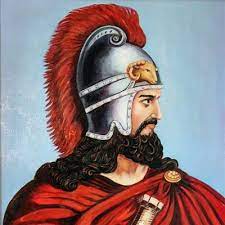Death of Vartan Mamigonian (May 26, 451)

The Armenian Church commemorates the 1,036 martyrs of the Vartanantz War on Thursday before Poon Paregentan, while the Feast of Ghevontiantz, two days before, commemorates the priests who also gave their lives in the defense of faith.
However, the battle of Avarayr, the highlight of the Vartanantz War, was fought on May 26, 451, the actual date when Vartan Mamigonian, the heroic leader of the Armenian forces, made the ultimate sacrifice against the superior Persian army.
Vartan Mamigonian was born in 388, right after the division of Armenia between Persia and Byzantium. He was the elder son of sparapet (generalissimus) Hamazasp Mamikonian and Sahakanush, the daughter of Catholicos Sahak I Partev. He studied at the school that St. Sahak and St. Mesrop Mashtots had opened in Vagharshapat, the capital of Armenia, right after the invention of the Armenian alphabet. By order of emperor Theodosius II, he was recognized as stratelates (general) of Byzantine Armenia in Constantinople (420). Two years later, he left for Ctesiphon, the capital of Persia, where Sasanid king Bahram V (420-438) acknowledged him as Armenian sparapet, and after the fall of the Arshakuni (Arsacid) dynasty in Persian Armenia (428), he was confirmed as sparapet of the marzpanate (border province) of Armenia. In 442, by order of Bahram V’s successor, Yazdegerd II (438-457), the Armenian cavalry led by Vartan Mamigonian fought against the Kushans, who had invaded Persia.
In 449 Yazdegerd II embarked into a policy of assimilation and called upon the Armenians by decree to renounce Christianity and become Zoroastrians. An assembly gathered in Artashat with the participation of Vartan Mamigonian refused the Persian request. Georgians and Caucasian Albanians also sent similar refusals. The representatives of the Armenian, Georgian, and Caucasian Albanian governments, along with Vartan Mamigonian, were called to Ctesiphon in April 450. Yazdegerd II demanded from them to abjure the Christian faith, threatening them with exile along with their families and confiscation of their properties. The princes decided to accept the demand as a formality and revolt as soon as they returned. However, Yazdegerd II kept Ashusha, the prince of Gugark, and the sons of Vasak Siuni, the marzpan of Armenia, as hostages.
The Persian king sent back the Armenian noblemen with 700 magi and a guard, with instructions to turn the churches into pagan temples and build fire altars. After the Armenians captured the magi when they tried to turn the church of the town of Angegh into a Zoroastrian temple, Vartan Mamigonian called an assembly and declared that his conversion was untrue.
The Armenians prepared for war. Vartan sealed a military pact with the governors of the Georgians and Albanians, and asked for help from Byzantium, but emperor Marciano refused. Vartan helped the Albanians to repel a Persian invasion in the same year.
After Vasak Siuni refused to join the rebellion, fearing for his children and arguing that victory was impossible without Byzantine help, Vartan returned to Armenia and took the government in his hands.
The decisive clash with the Persian army happened on May 26, 451, in the field of Avarayr, in the district of Artaz (province of Vaspurakan). Vartan Mamigonian divided the Armenian forces (66,000 soldiers) into four sections, one of them under his immediate command. He attacked the first, but he was surrounded and died in battle. Despite his death, the Persians, who had superior forces (90,000 soldiers and elephants) were forced to call back their troops due to the Armenian resistance. The plan to force Armenian conversion was shelved.
The heroic figure of Vartan Mamigonian has been a frequent subject of literature, sculpture, painting, and theater. The liturgical hymns Norahrash, by Catholicos St. Nerses Shnorhali, and Ariatsialk, by Catholicos Petros I Getadartz, were devoted to the heroes of Vartanantz.
Churches dedicated to Vartan Mamigonian and the Vartanantz heroes, who were later canonized, have been built in different provinces of Armenia since medieval times, then in Armenian communities and now in the Diaspora. Two churches in the Eastern Prelacy remember them: Sts. Vartanantz Church of Ridgefield, New Jersey, and Sts. Vartanantz Church in Providence, Rhode Island.
